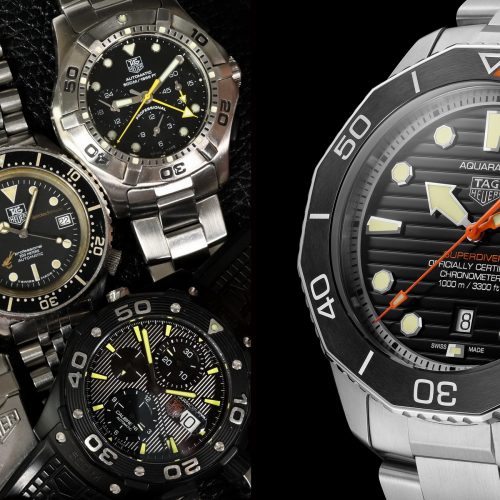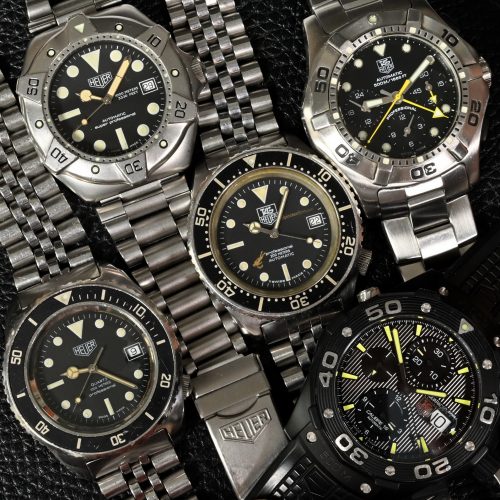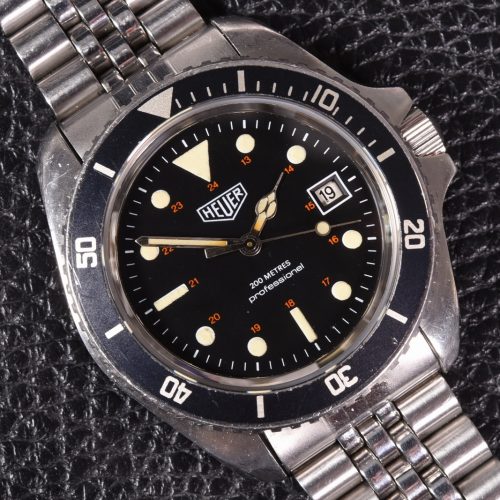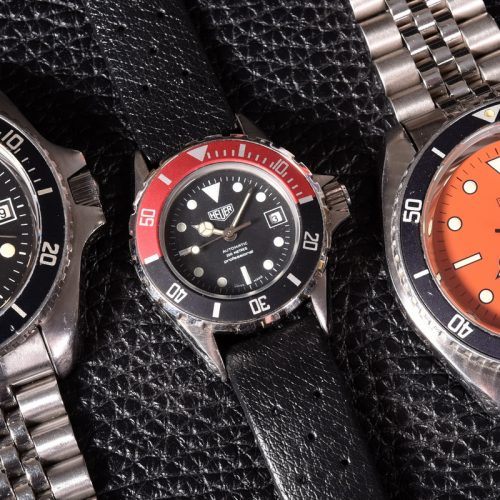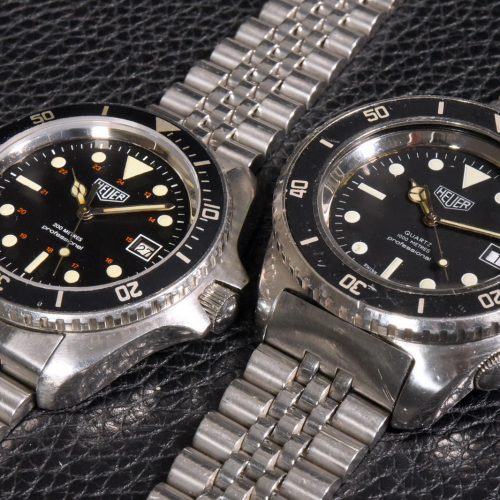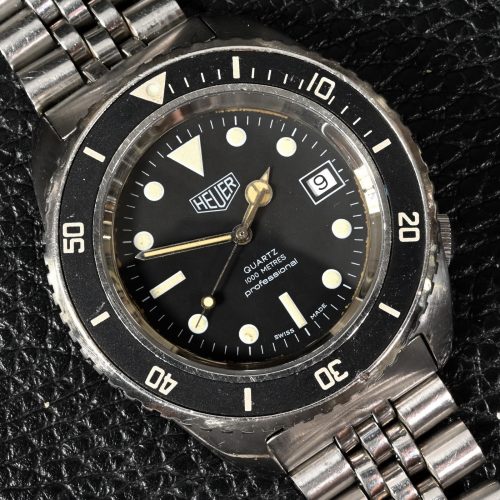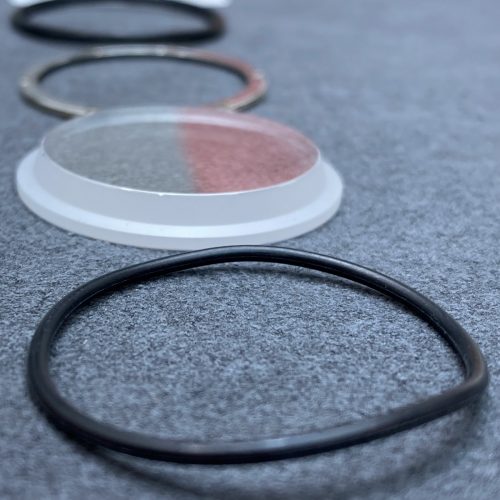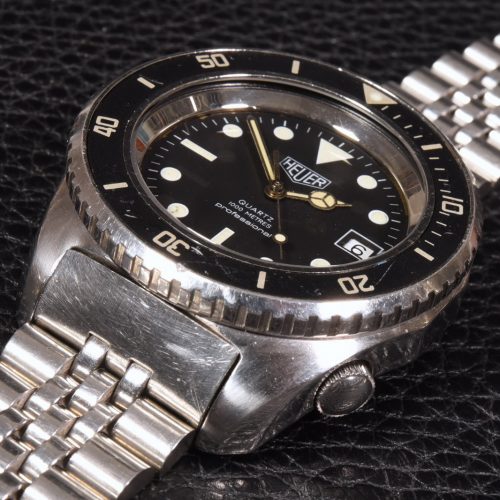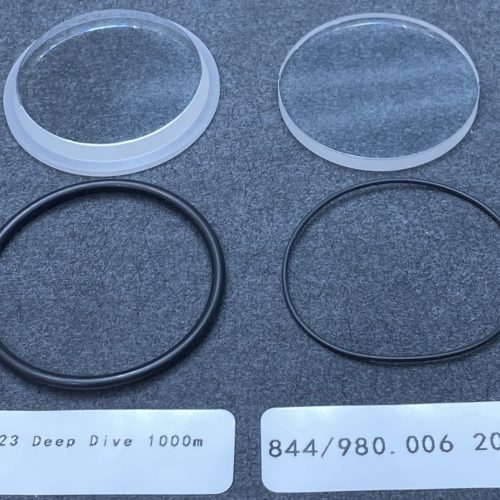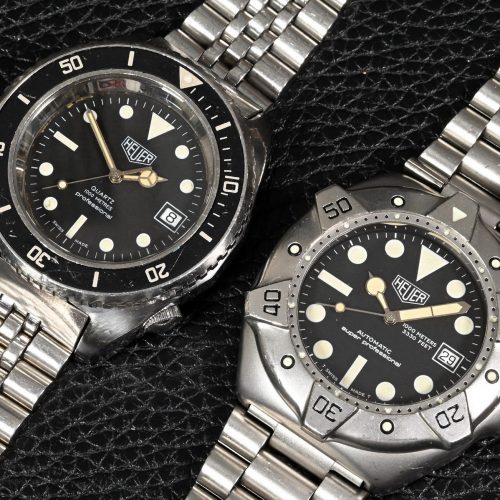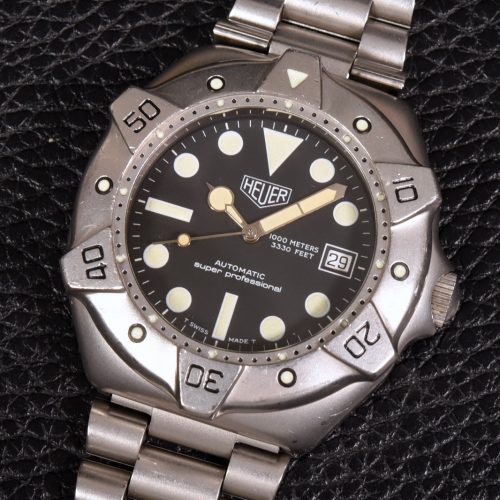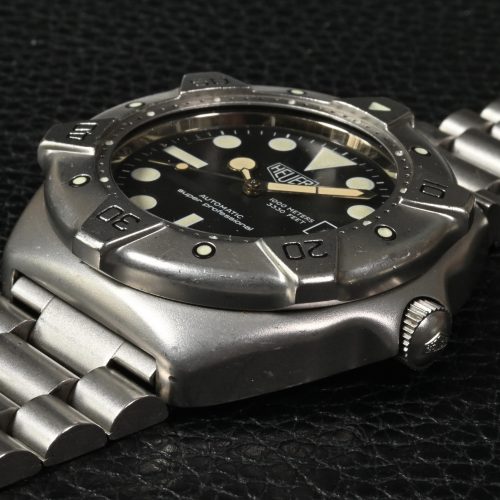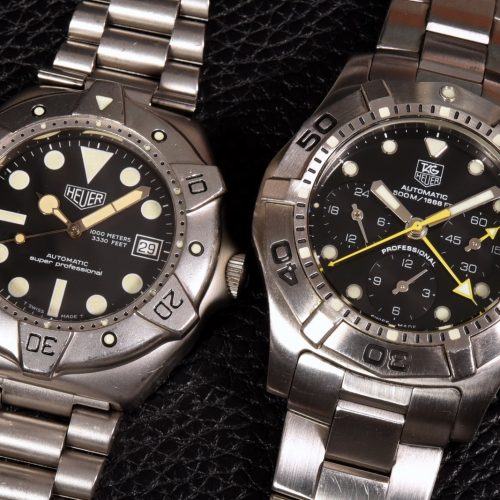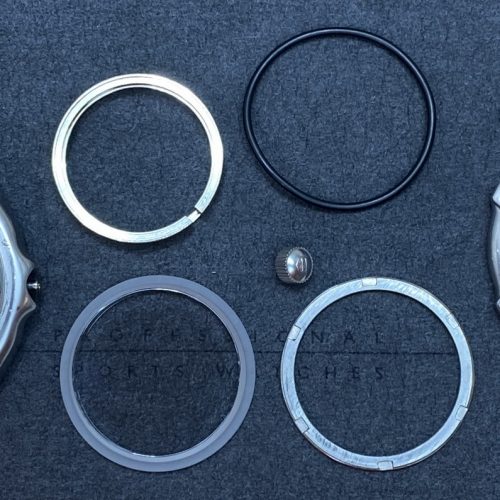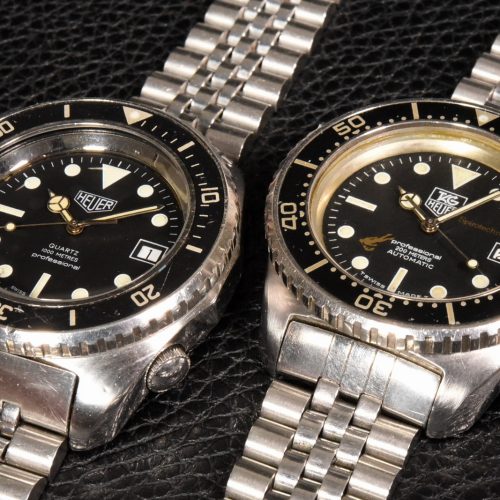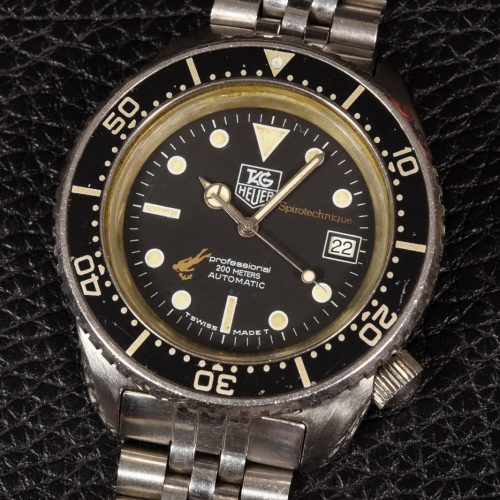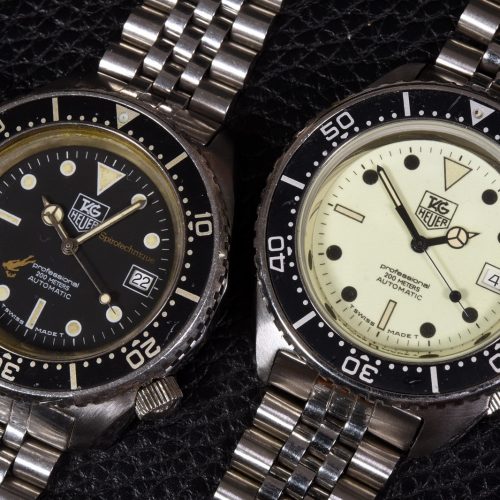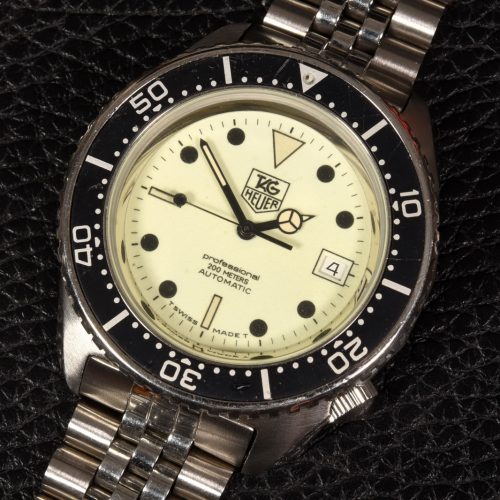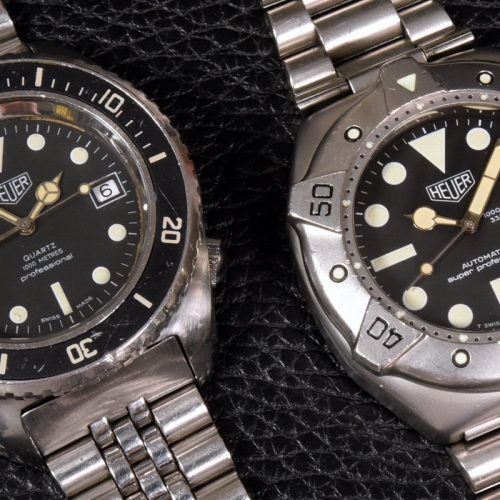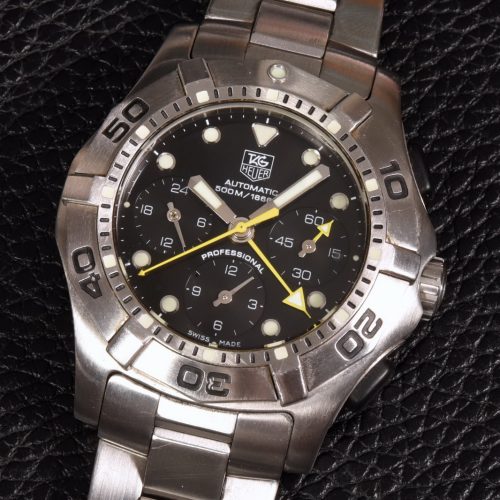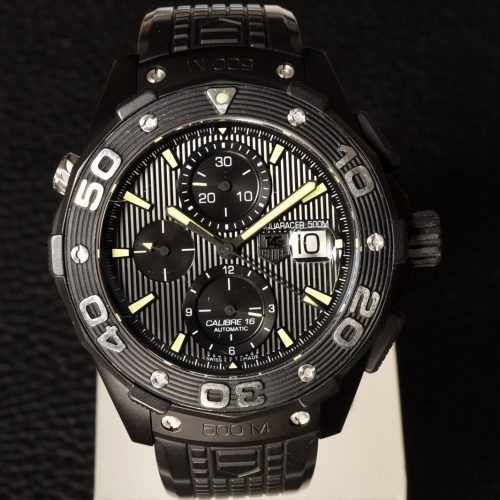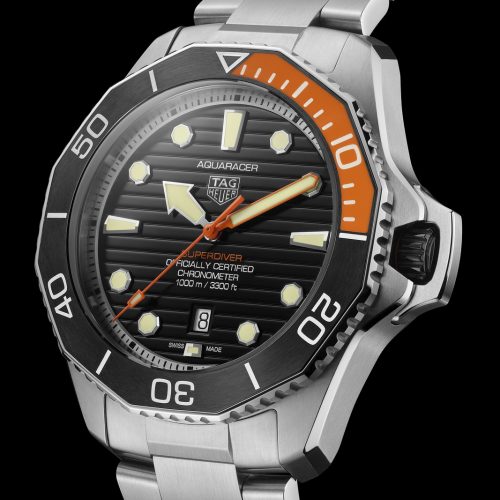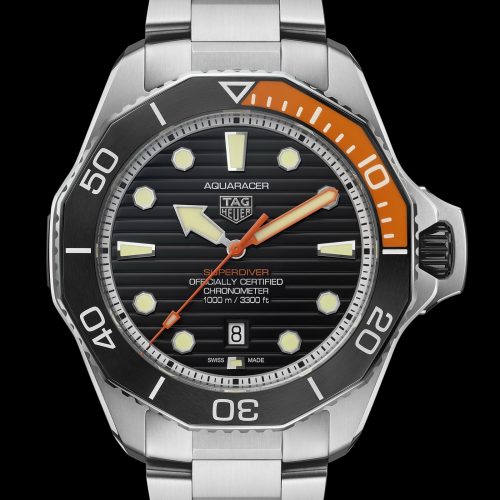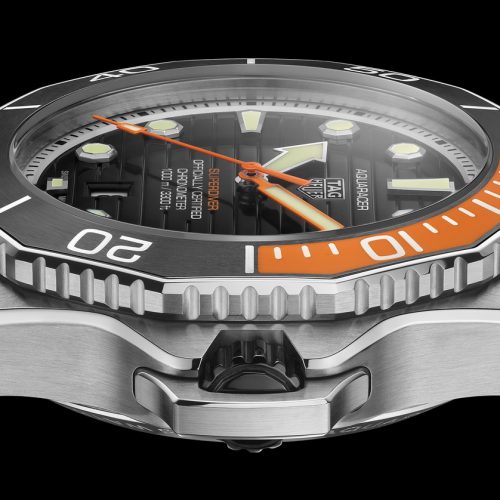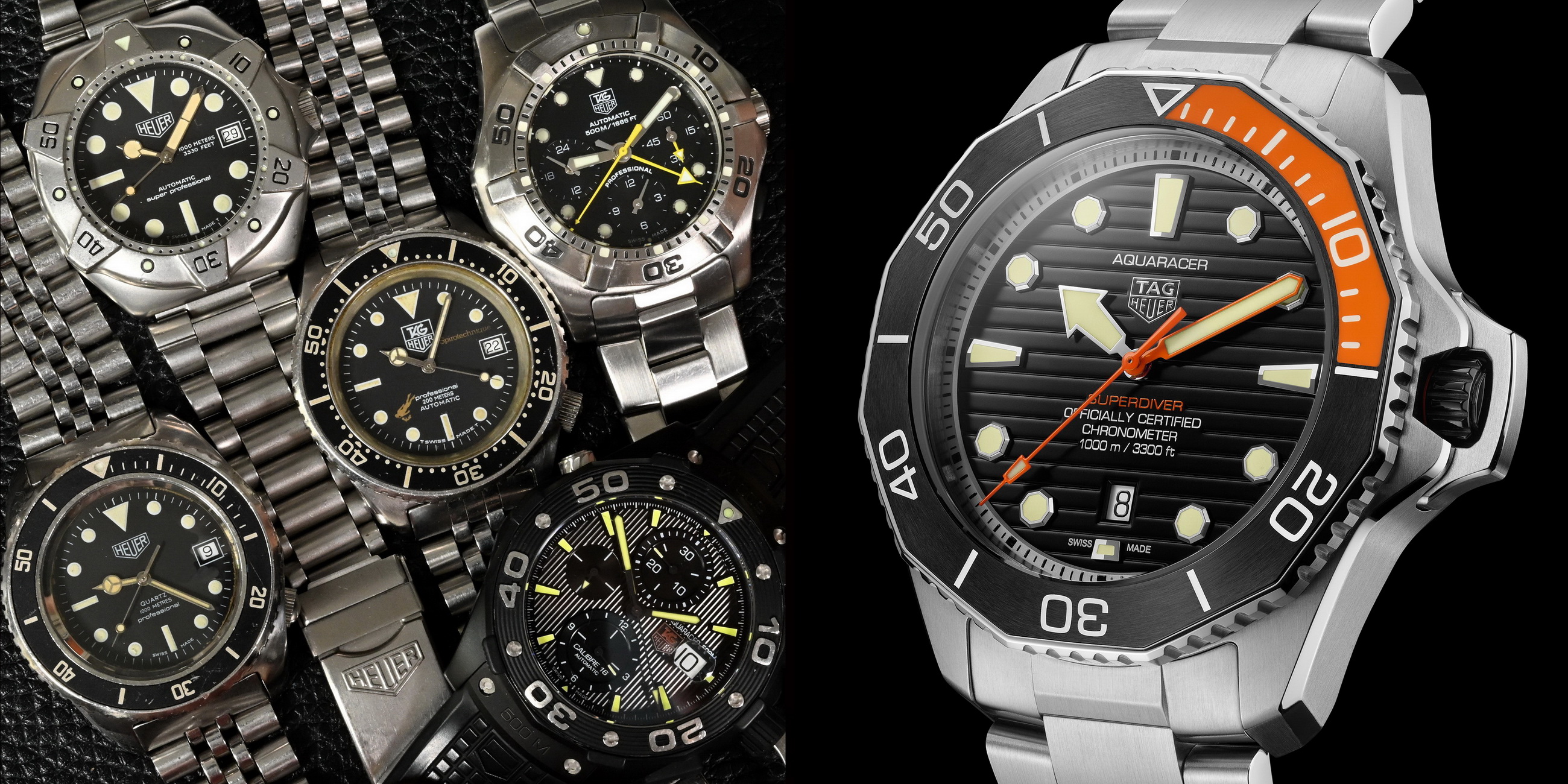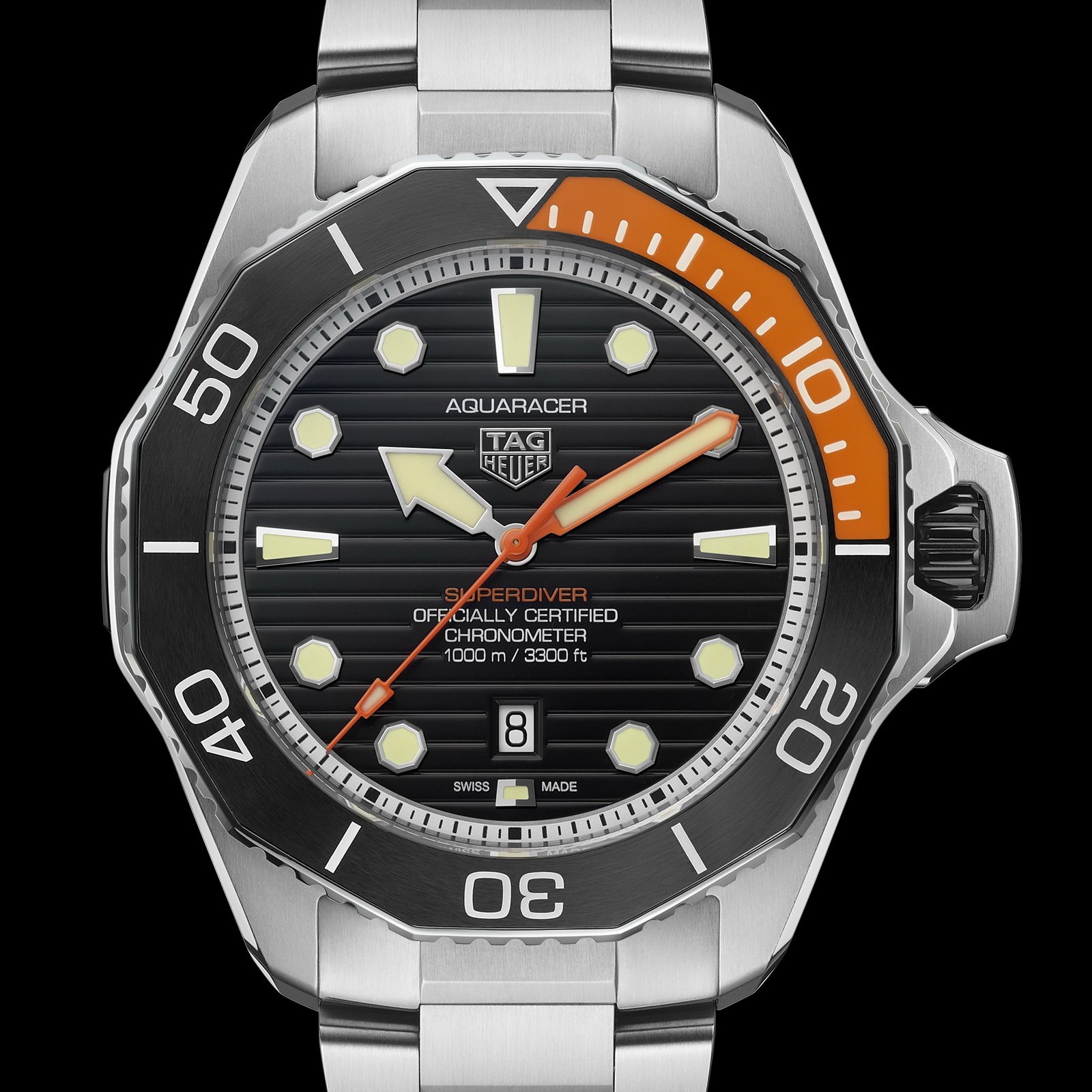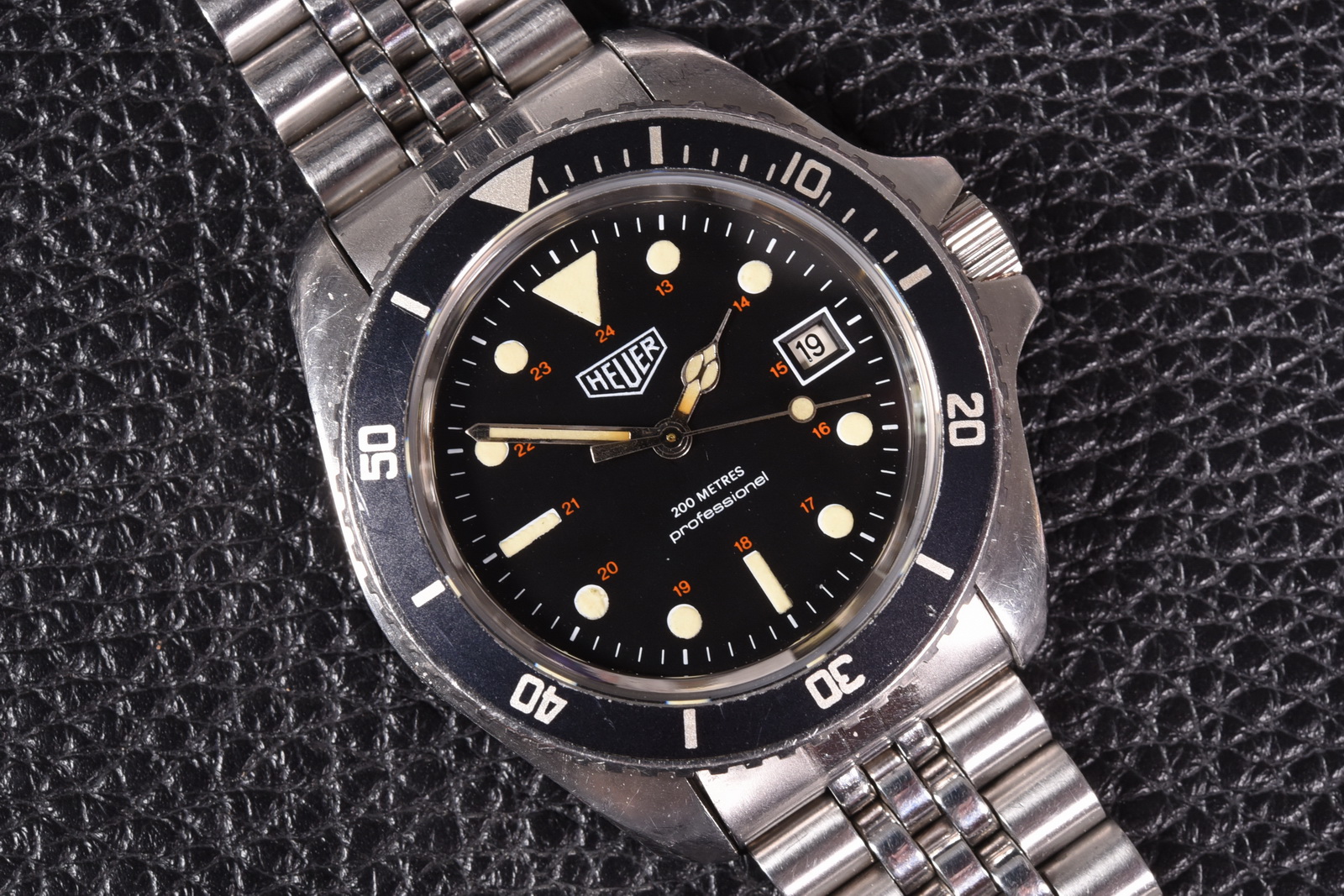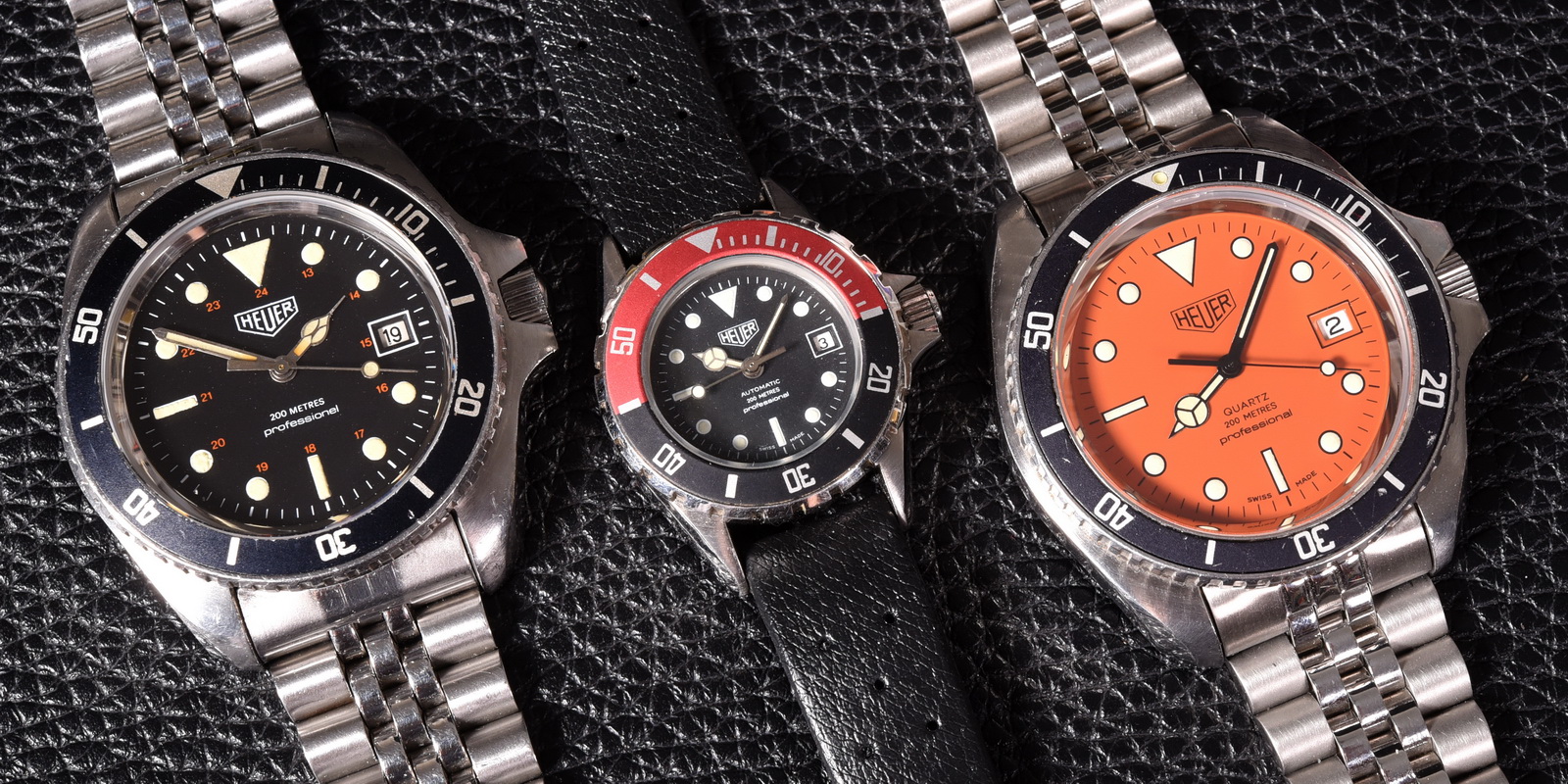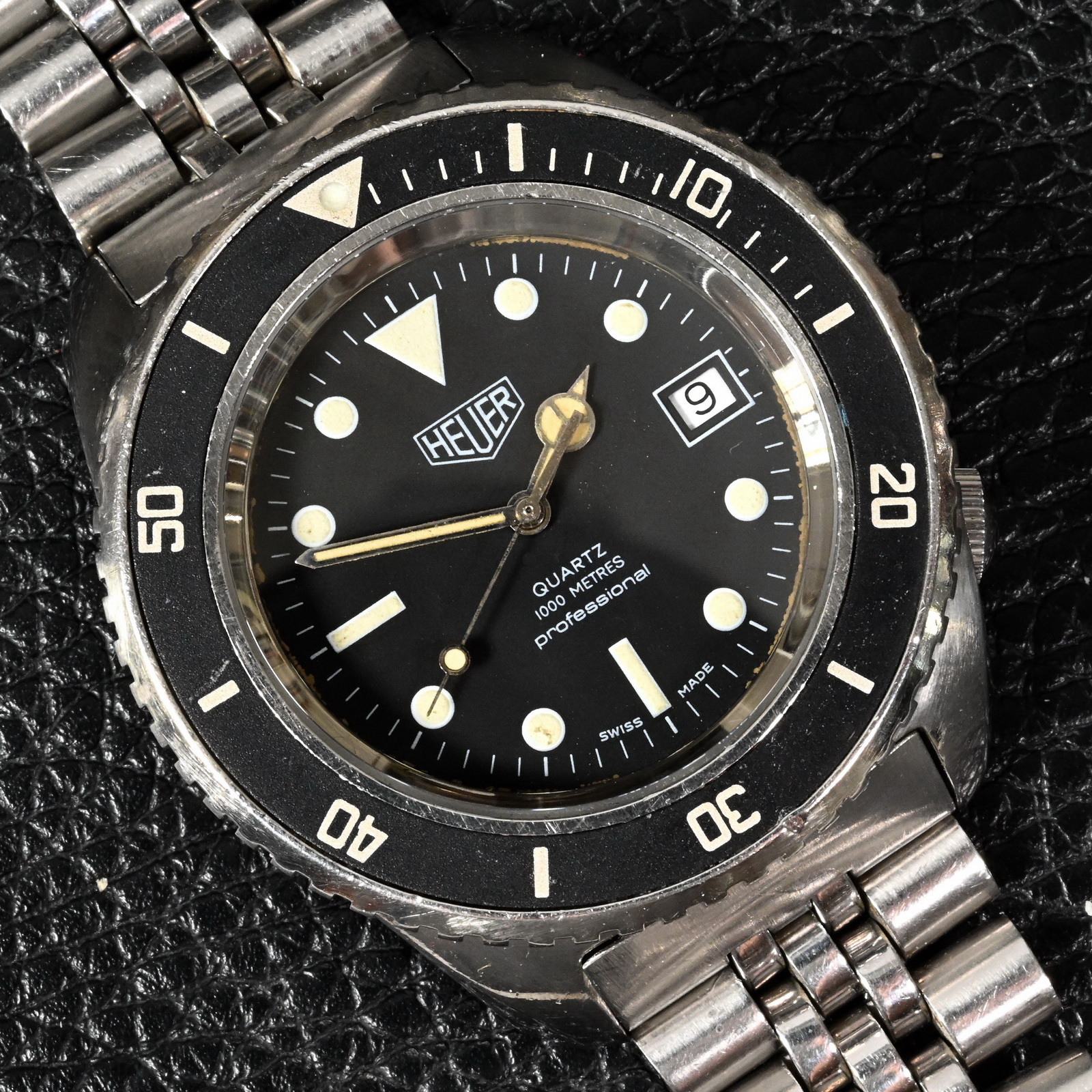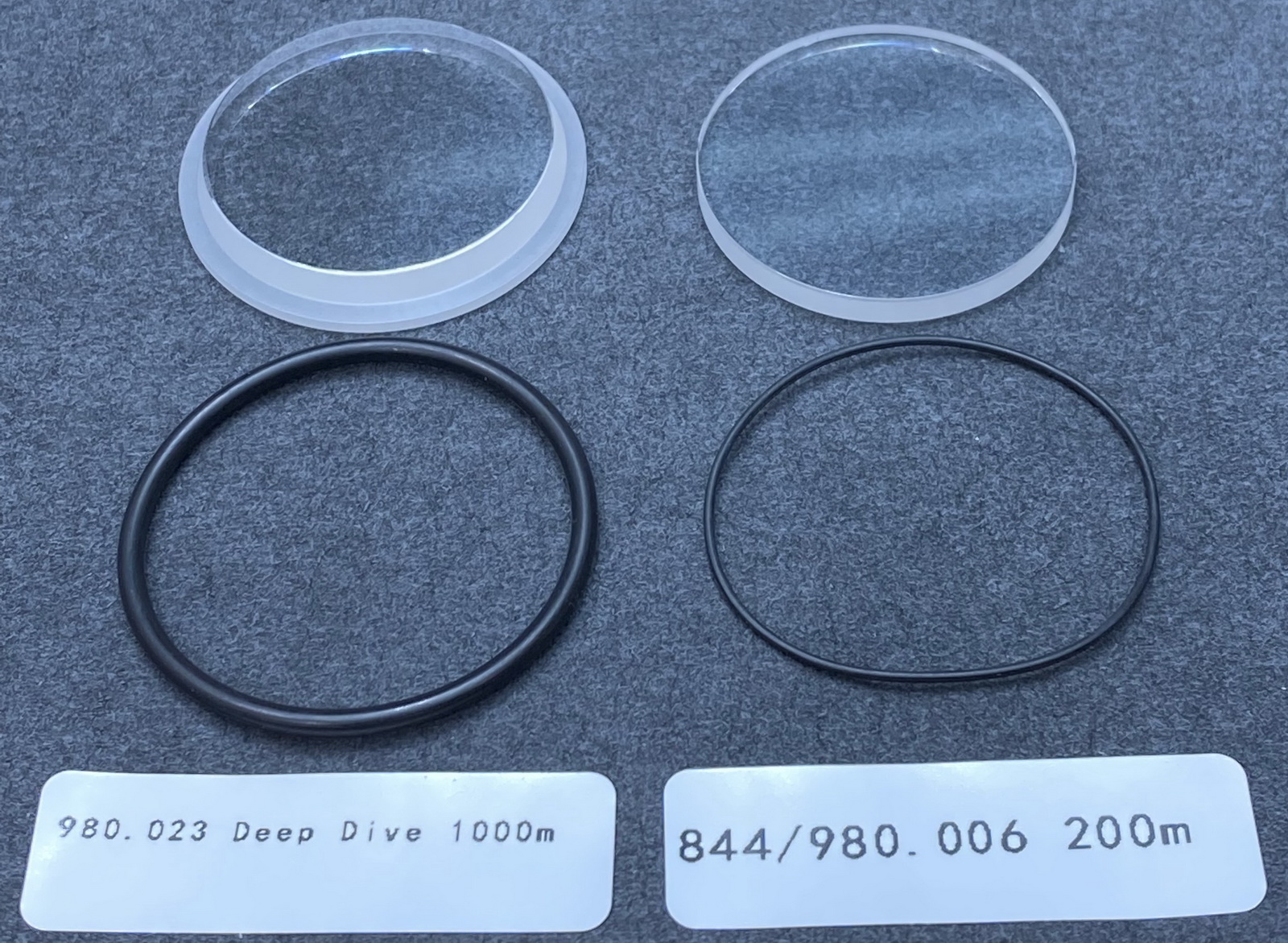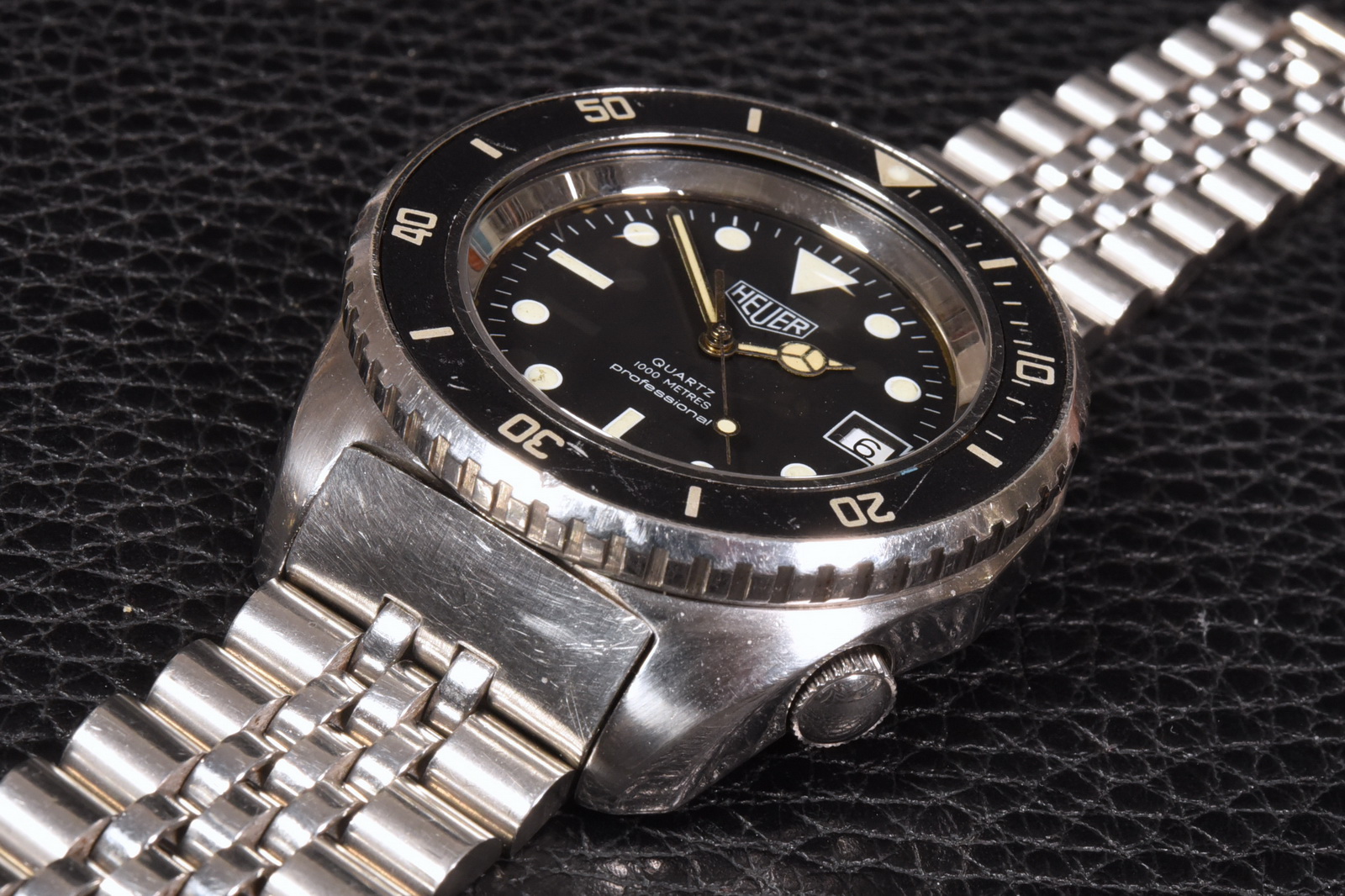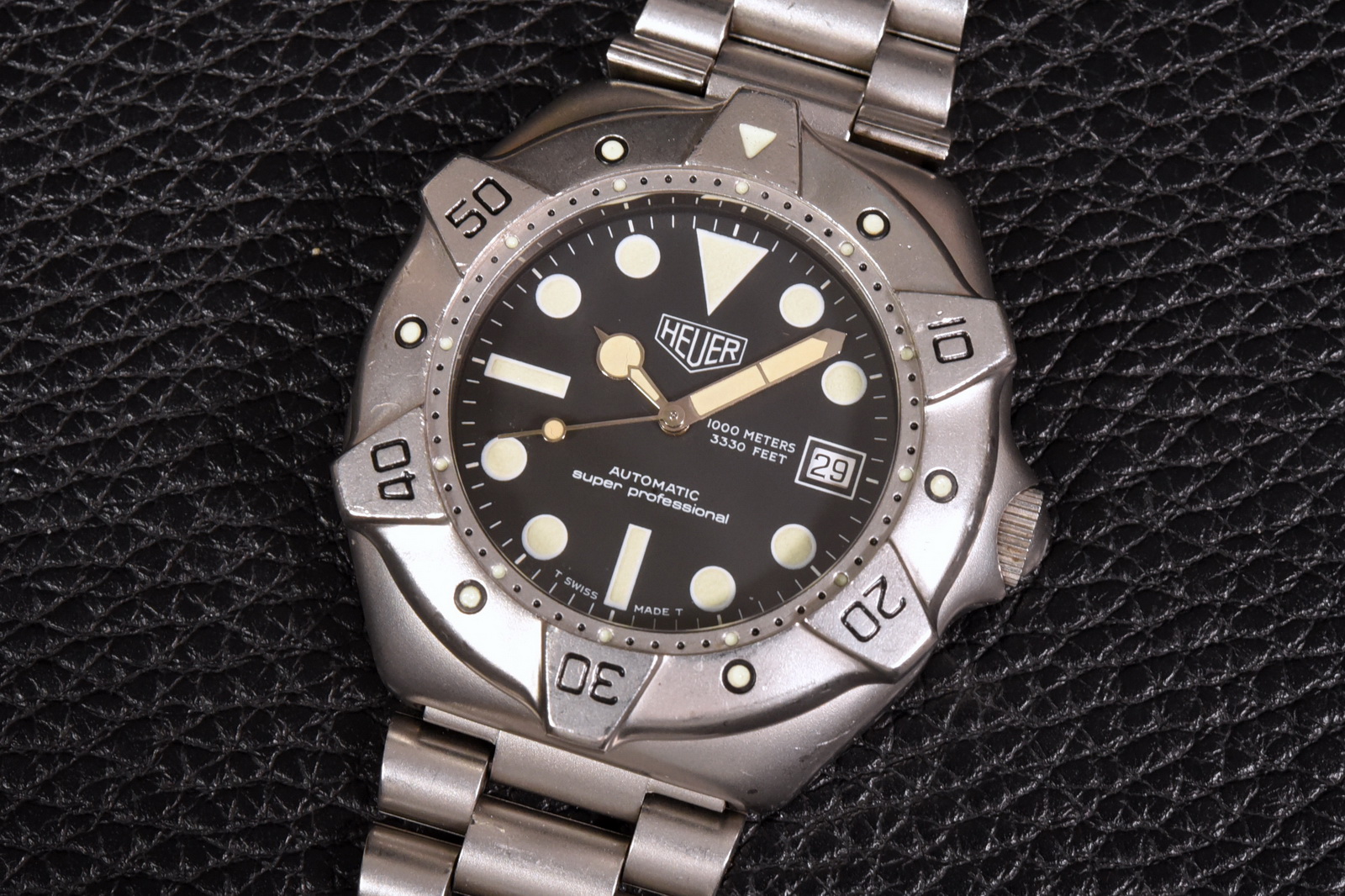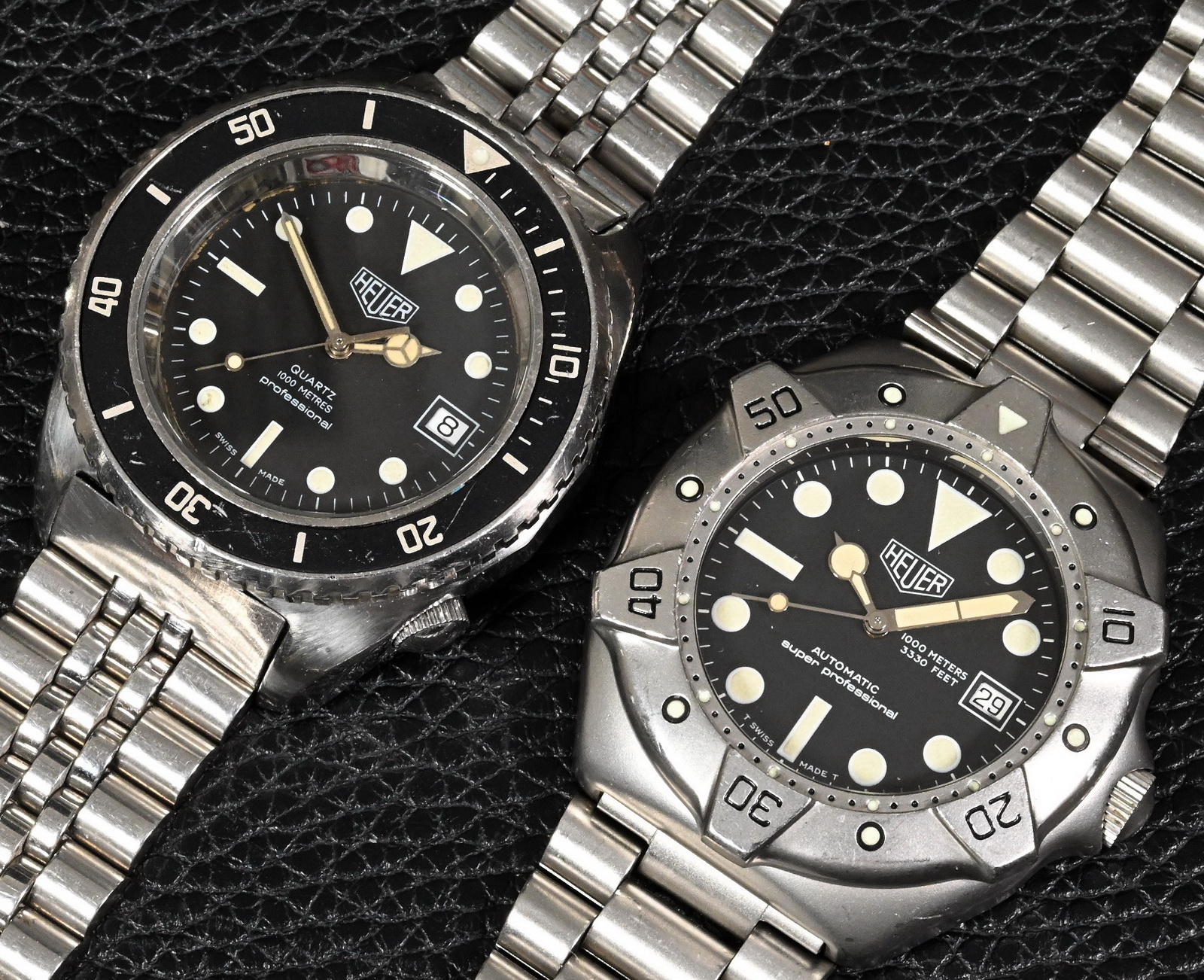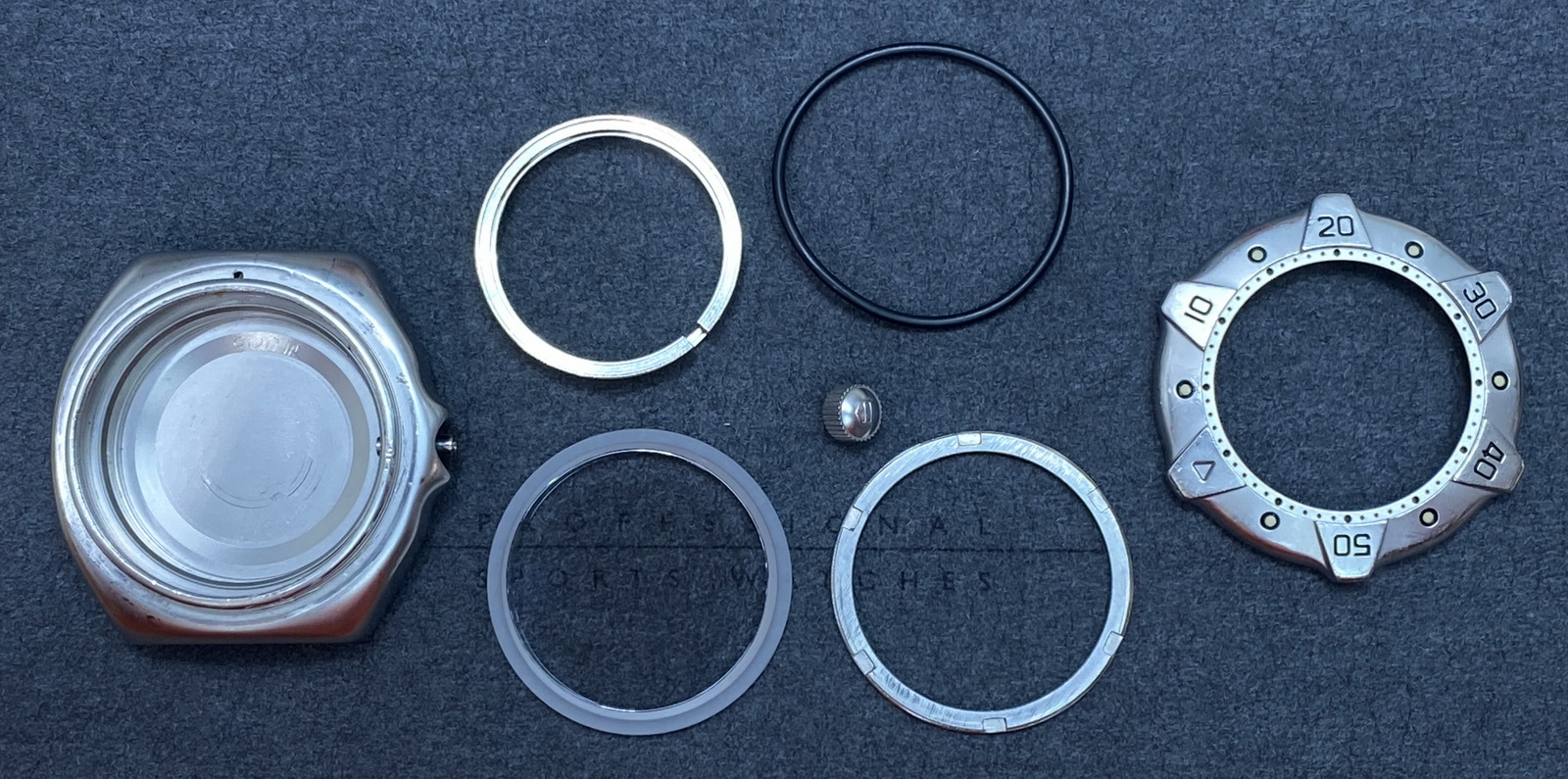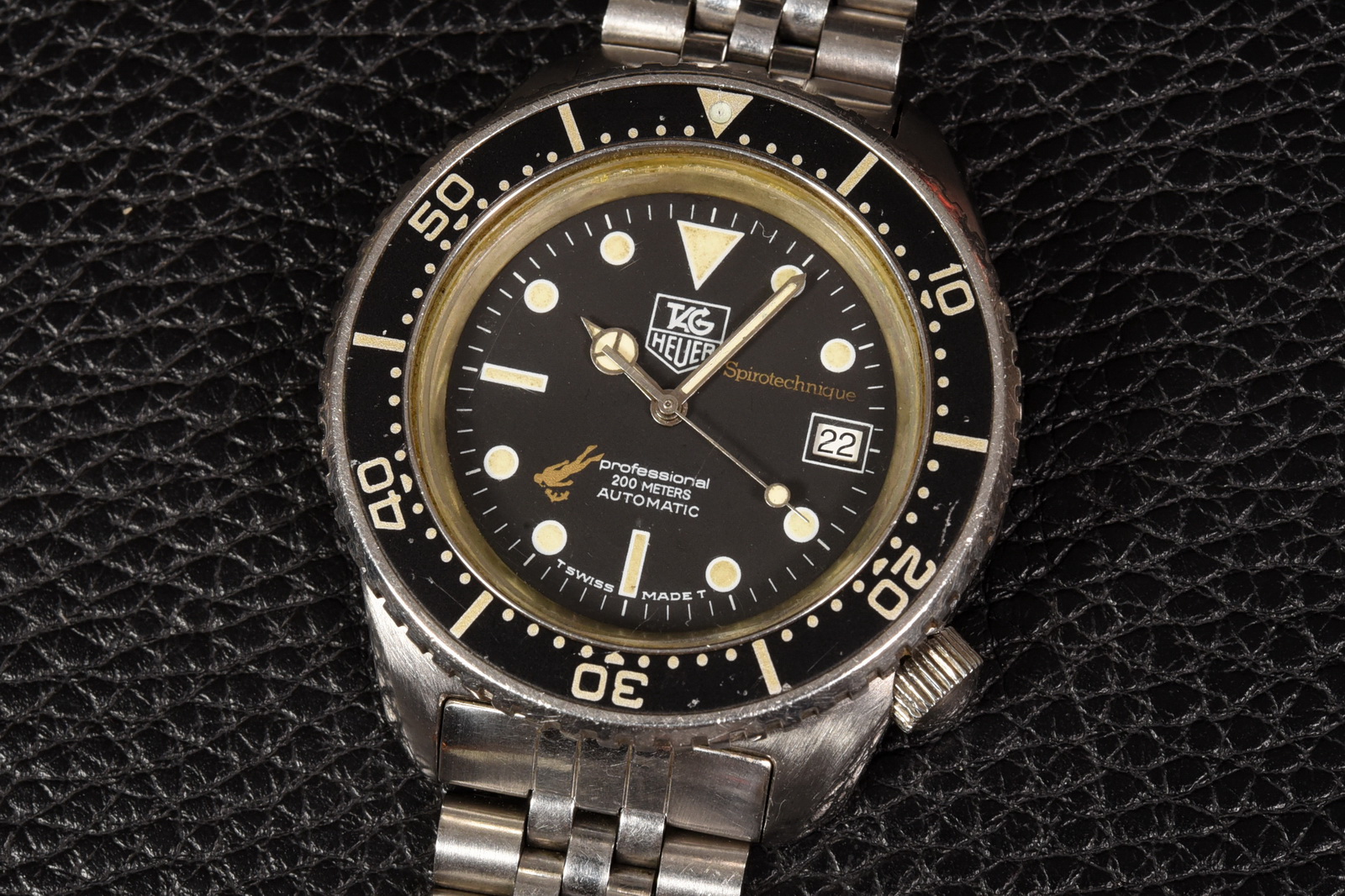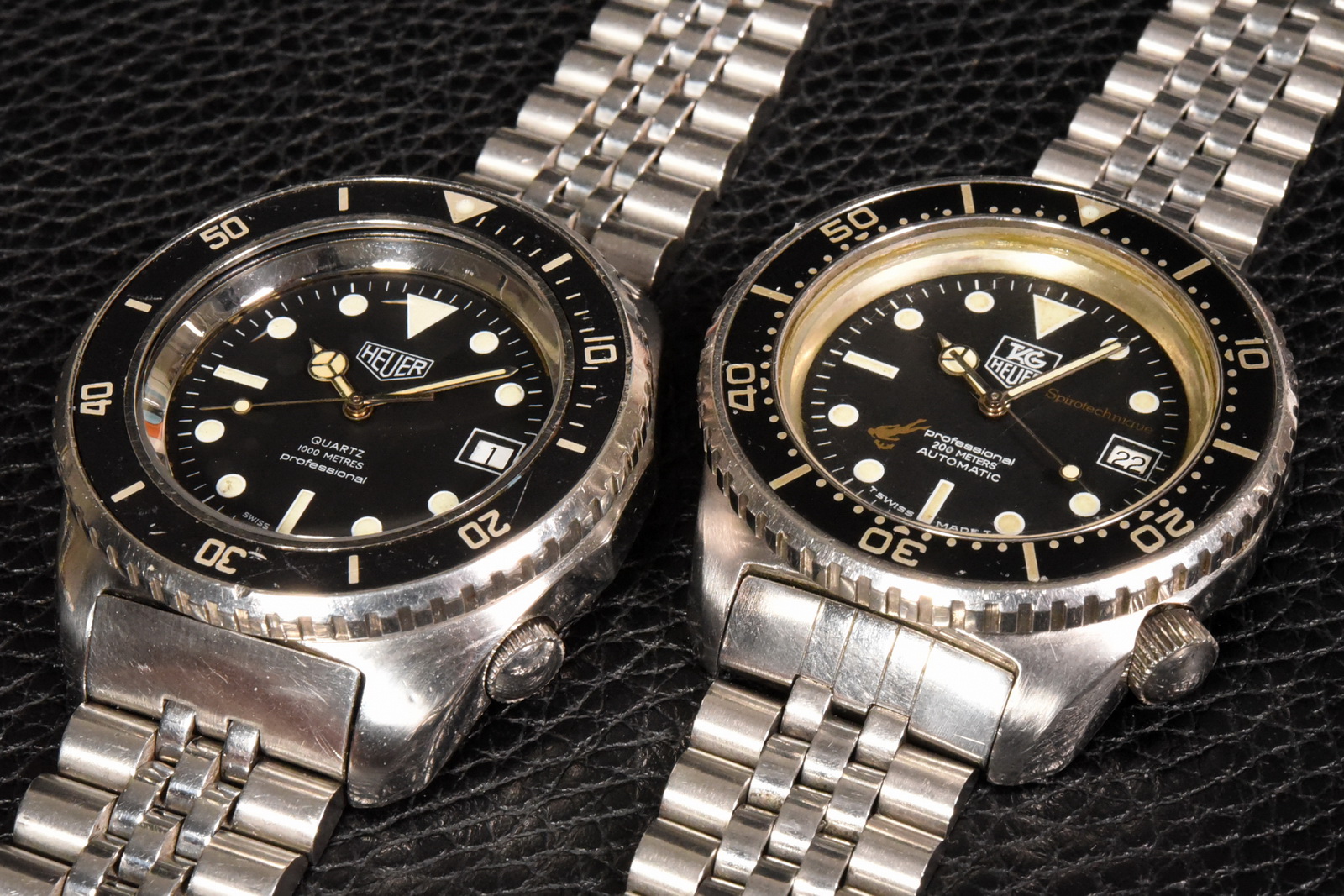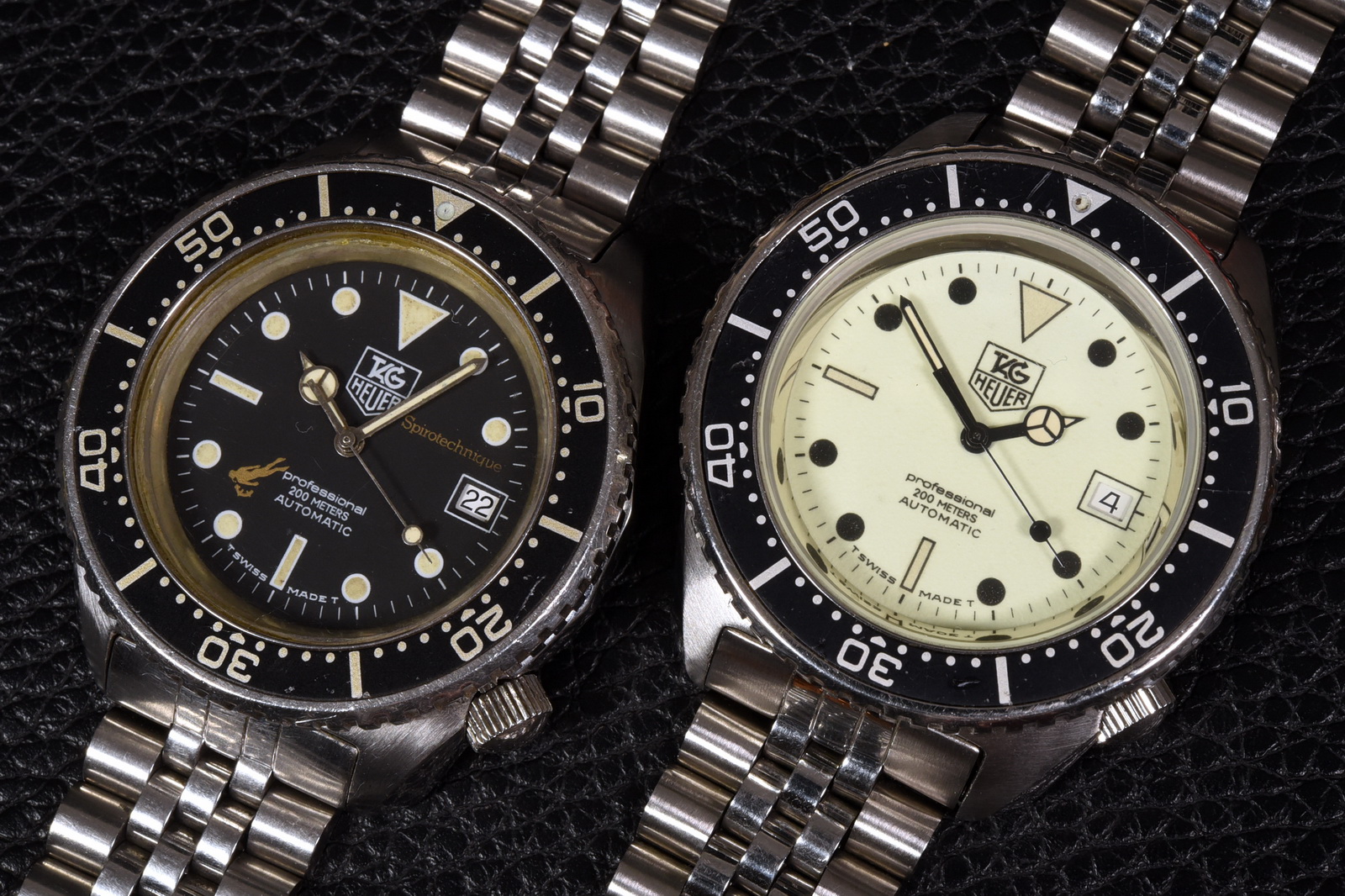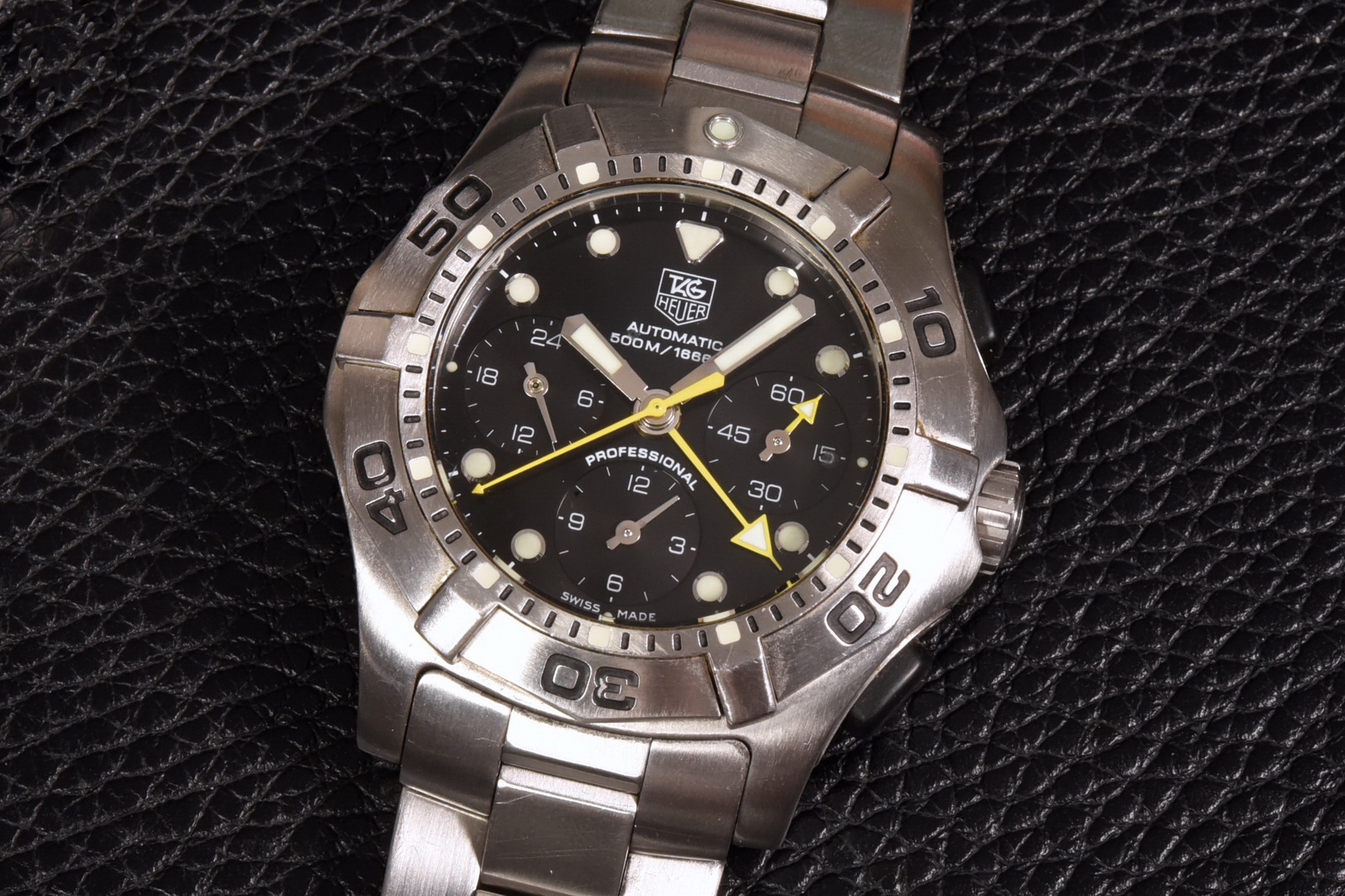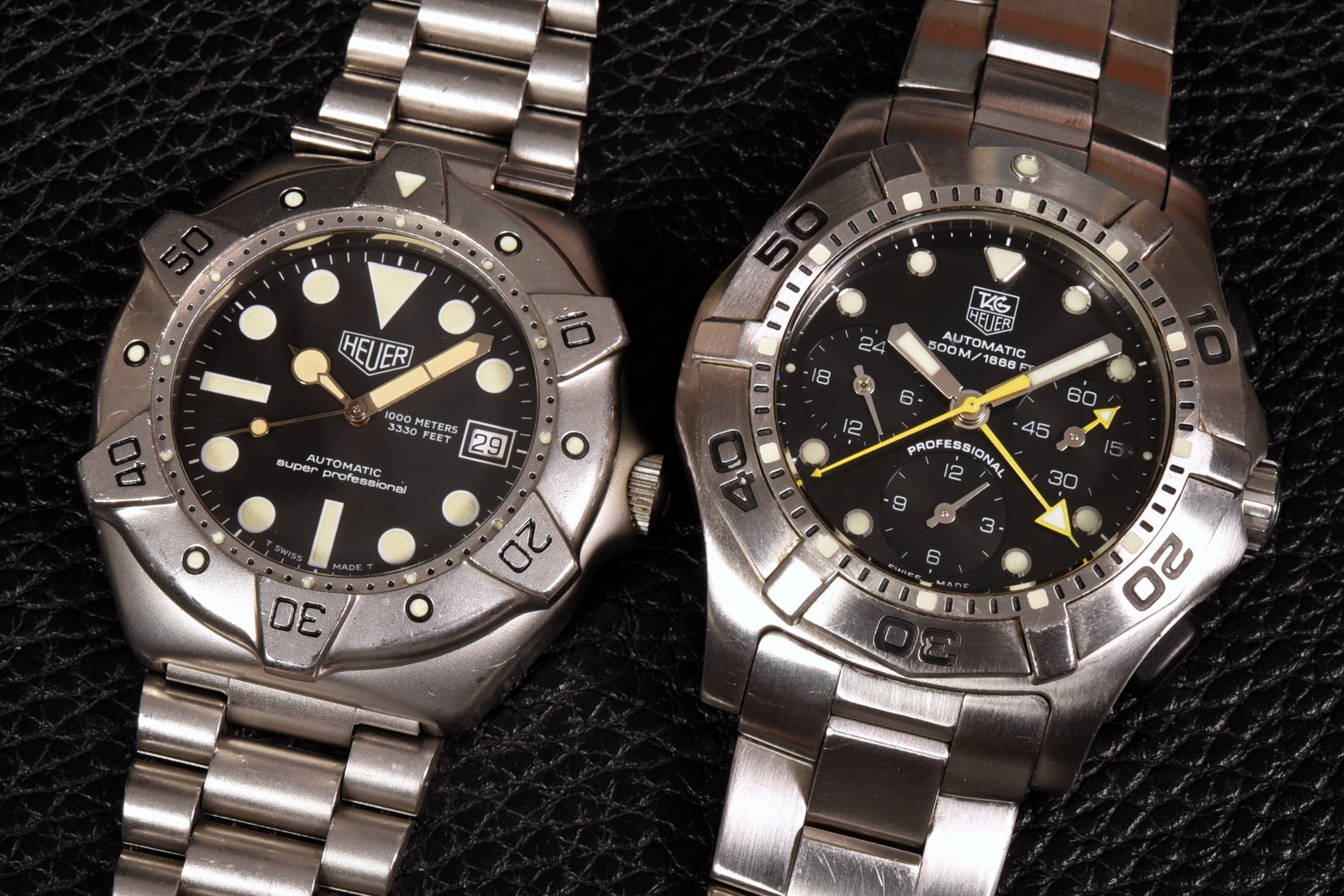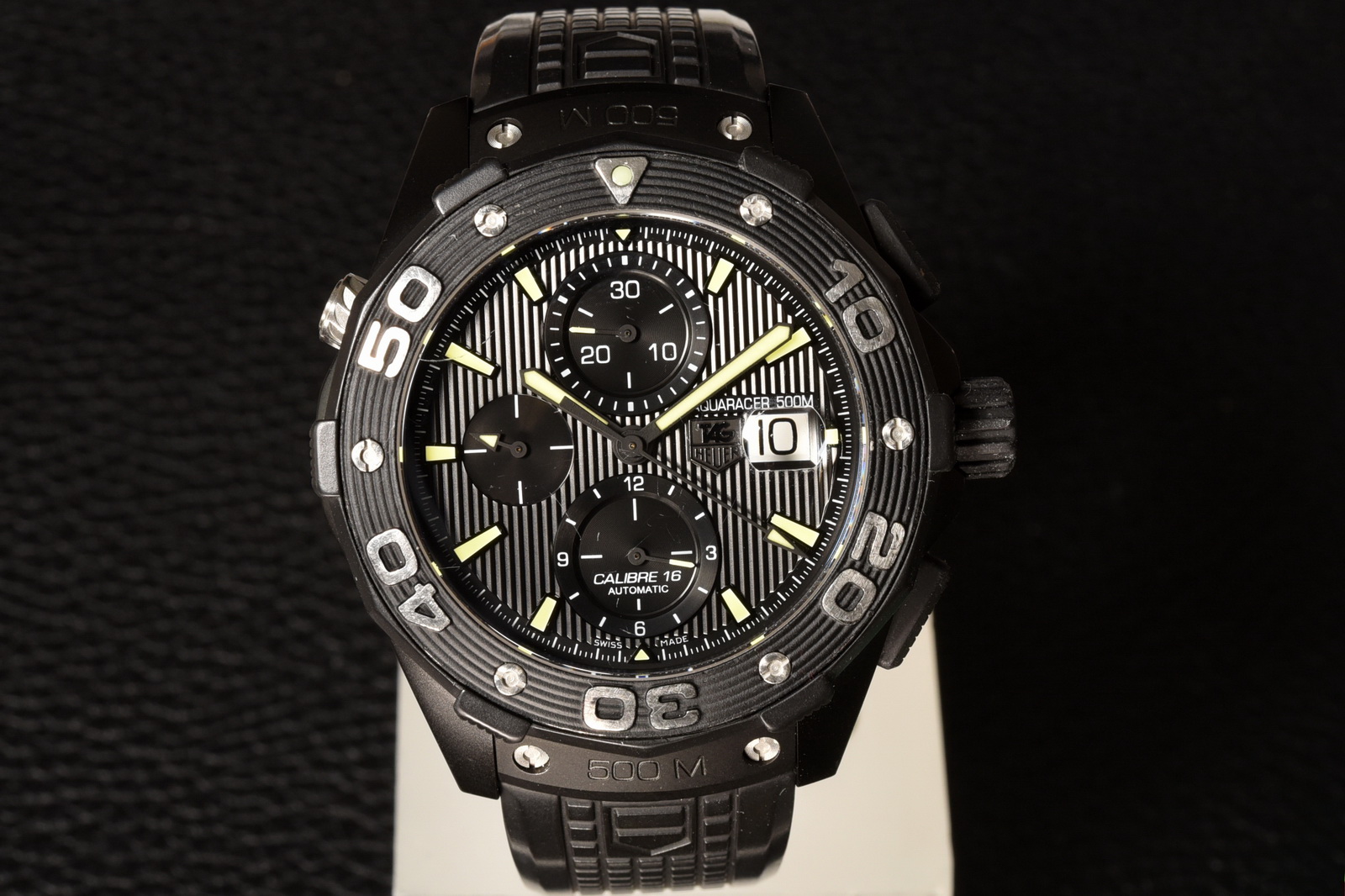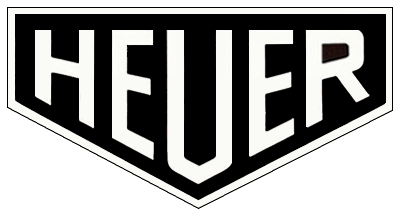With TAG Heuer today introducing its new Aquaracer “Superdiver” model (Reference WBP5A8A), waterproof to 1000 meters, it is interesting to look back through some of the brand’s previous deep dive watches and chronographs. Prior to introducing this new Aquaracer, Heuer had produced only two watches with 1000 meter depth ratings, with these two watches being introduced in 1982 and 1984. We will focus on these two 1000 meter watches from Heuer, and and three other TAG Heuer dive watches that paved the way for the newest Aquaracer.
Of course, to write about watches with 1000 meter depth ratings itself raises the question of why enthusiasts are so keen on these watches (or for that matter watches with 300 or 500 meter depth ratings. The deepest dive on record for a human being is 332 meters, and a watch with a 200 meter depth rating will be more than sufficient for even the best swimmer or diver.
My view is that watch enthusiasts pursue “deep dive” or “ultra deep dive” watches for the same reasons that car enthusiasts love the street cars that have 500 horsepower, can reach 197 miles per hour and go from 0 to 60 in 3.2 seconds. Of course, we rarely get close to the “top end” of the machine, but we admire the engineering, materials and construction that give us this capability. And besides, we will feel that much more confident if we are wearing our 1000 meter dive watch when we get caught in a rainstorm or roll up our sleeves to do the dishes.
1982 – Heuer “Deep Dive” (1000 Meters) – Reference 980.023
Heuer introduced its first dive watches in 1978, with the Reference 844 being the flagship of these very first models. These first Heuer dive watches were waterproof to 200 meters, and used either quartz or mechanical movements. The word “Professional” on the dial signified that, rather than being designed for recreational swimmers, sailors and surfers, the watches were built for those who actually pursued diving as an occupation. Diving had become a popular pastime in the 1960s and 1970s, and Jack Heuer has described how – in the late 1970s — dealers who sold diving equipment needed a source of reliable, affordable dive watches.
In the late 1970s, the gold standard of popular dive watches was the Rolex Submariner and Jack Heuer is unapologetic in admitting that the Rolex dive watches were the starting point for the line-up of dive watches that Heuer would develop. One significant difference, however, was that most of the early Heuer dive watches would use quartz movements, which offered better accuracy than their mechanical counterparts and less wear and tear on the crown from winding and setting the watches. As production of quartz watches ramped up over the years, Heuer’s use of quartz movements would also offer a price advantage compared with other brand that used mechanical movements.
From 1978 to 1981, Heuer introduced a variety of dive watches, totaling around 20 different models. Dials were black or orange, cases were in stair-steps from 28 millimeters up to 42 millimeters, and movements were either automatic or quartz. For enthusiasts who were more focused on “desk diving”, Heuer even offered dive watches with day / date displays.
Then in 1982, Heuer made a big jump, or perhaps we would call it a big dive, offering a watch that at first glance looked a lot like the Reference 844 and Reference 980.xxx predecessors, but the “1000 meters” printed on the dial confirmed that this was a very different animal. While many dive watches of the 1960s and 1970s used radically different styles of cases on their way to securing the 1000 meter depth rating (for example, the monobloc cases used for the Jenny Caribbean, the first 1000 meter dive watch), Heuer’s Reference 980.023 (which collectors call the “Deep Dive”) followed the basic geometry of Heuer’s previous dive watches, with the exceptions being the Deep Dive’s thicker case and the crown being moved to the four o’clock position.
While our initial impression of the Deep Dive watch may suggest that achieving the 1000 meter depth rating is a matter of adding metal to the case, an inspection of what’s inside the case demonstrates that building a watch that will operate reliably at this depth requires the addition of more than metal. In fact, two keys to the 1000 meter depth rating for the Heuer Deep Dive were incorporating a significantly thicker crystal (and building a collar to retain the crystal) and using larger gaskets to seal the case-back. Yes, stainless steel is added to the case, but the purpose of this additional steel is to retain the thicker crystal and to provide larger seating surfaces for the oversized gaskets. The crystal retaining system prevented the crystal from being pushed out of the case and/or distorting during ascents and descents.
Put it all together, and Heuer’s first Deep Dive watch measured 41.3 millimeters across the bezel, compared with 39.5 millimeters for the Reference 844. The real difference, however, came in the thickness and weight of the two cases, with the Deep Dive having a thickness of 15.4 millimeters and weighing 138 grams (on its Jubilee bracelet), and the Reference 844 coming in at 12.7 millimeters thick and a weight of 121 grams (on the same style bracelet).
The June 1982 price list shows that the Deep Dive, on a rubber strap, sold for $295.00, which was over twice the price of the Reference 844. The Heuer Deep Dive (Reference 980.023) would be sold by TAG Heuer through the end of the 1980s.
1984 – Heuer Super Professional (1000 meters) – Reference 840.006
In 1984, Heuer embarked on a new path to create a dive watch with a 1000 meter depth rating. The Deep Dive (Reference 980.023) had followed the style of the traditional dive watch, but the new “Super Professional” (Reference 840.006) would use a style that was common for deep dive watches of the 1960s – a monobloc case, with an other-worldly appearance. The case had a bead-blasted finish, with rounded edges on the case and bezel replacing the sharp lines of the cases that Heuer had used for its previous dive watches. The most prominent feature of the new Super Professional was the grips on the bezel, each a raised trapezoid, marked to show 10 minute increments.
Compared with the Deep Dive, the Super Professional looked and felt sleek on the wrist. The case was significantly slimmer than that of the Deep Dive, with a thickness of 14 millimeters, compared with the 15.4 millimeters of the early Deep Dive models. The Super Professional case measures 40 millimeters across the bezel, or 42.8 millimeters measuring across the grips of the bezel. While the Super Professional weighed 149 grams (10 grams more than the Deep Dive), most of this differential is accounted for by the bracelet, with the three-row bracelet, similar to that used on the 2000 Series, feeling much more substantial than the five-row bracelet on the Deep Dive. The Super Professional was a unique design, not used by any other brands. (The Zodiac Super Deep Wolf (Reference 506.54.44), with its “buzz saw” style bezel, offers an interesting comparison, but this Zodiac watch uses a screw-back case, rather than a monobloc design).
With its monobloc case, the movement of the Super Professional is accessed from the front of the watch, rather than by removing the case-back. Removing the bezel allows access to a retaining ring, which is unscrewed from the body of the case with a normal case-opening tool. From there, the movement is accessed by lifting the crystal out of the case and separating the movement from the crown by opening the split-stem that holds the crown in place.
In addition to the standard Super Professional, TAG Heuer offered a version with a gold-plated bezel (Reference 844.006), as well as a version in a black-coated case.
The Super Professional would have a long run in TAG Heuer’s collection of dive watches, being phased out circa 2002, coinciding with the introduction of the Aquaracers, which would become TAG Heuer’s new collection for deep diving.
1986 to 1990 – TAG Heuer Spirotechnique (200 meters) – Reference 180.023
Until the 1940s, diving had been the province of professional and military divers, but the development of the first modern diving regulator by diver / explorer Jacques-Yves Cousteau and the engineer Émile Gagnan in 1943 would pave the way for diving to become a popular sport. La Spirotechnique was founded in 1946, to develop and mass-produce regulators and other diving equipment, including suits, masks and helmets.
The first watches designed specifically for diving were developed in the 1950s, and over the years Spirotechnique would offer a variety of dive watches produced by Triton, Doxa and Squale, with these watches being co-branded with Spirotechnique. In the late 1980s, Spirotechnique would offer the Heuer Reference 180.023, with the Spirotechnique name and logo on the dial.
The Reference 180.023 was a 200 meter dive watch, with an automatic movement. While the style of the TAG Heuer Spirotechnique dive watch follows the general form of the previous 1000 meter “Deep Dive”, Reference 980.023, with the depth rating of the Spirotechnique reduced from 1000 meters to 200 meters, the case was made considerably thinner.
The Heuer Spirotechnique has a thickness of 11.8 millimeters and a weight of 105 grams, considerably thinner and lighter than either the 1000 meter Deep Dive (at 15.4 millimeters and 138 grams) or the Super Professional (at 14 millimeters and 149 grams).
We can imagine that with Heuer having the Super Professional for those who wanted the 1000 meter depth rating, Spirotechnique could specify a thinner, lighter watch for its customers who would prefer a more “wearable” watch. Of course, building a watch with a 200 meter depth rating also offered some cost savings compared with the components and machining complexity required for the 1000 meter watch.
In addition to the standard Spirotechnique (Reference 180.023), TAG Heuer offered a version with an all-lume “night diver” dial and painted black hands (Reference 180.123), with this version not being co-branded for Spirotechnique.
2003 – TAG Heuer Aquagraph Chronograph (500 Meters) – Reference CN211A
With the tremendous success of its first dive watches, which were marketed as the 1000 Series collection, Heuer was quick to introduce the 2000 Series, in 1982. While the 1000 Series followed the style of traditional dive watches, the 2000 Series expanded the range considerably, offering a “completely new fashion look”. The 2000 Series collection offered a variety of colors and styles, and would also include Heuer’s first full collection of dive chronographs. Following the cues of the 2000 Series dive watches, the 2000 Series chronographs offered a variety of looks, with stainless steel and bi-metallc cases, dials in black, pewter and champagne, and both automatic and quartz movements. The 2000 Series chronographs had a depth rating of 200 meters, and followed the “fashion look” of the corresponding three-hand dive watches.
In 2003, TAG Heuer took the 2000 Series in a new direction, with the introduction of the 2000 Series Aquagraph chronograph, a professional dive chronograph with a 500 meter depth rating. While the 2000 Series collection of dive watches may have had its roots in “fashion”, the Aquagraph was all business, with elements of the design derived from the Super Professional (as shown below).
The brushed stainless steel case measures approximately 44.5 millimeters across the dial, with a thickness of 16.2 millimeters, and including the solid oyster-style bracelet, the Aquagraph tipped the scale at 225 grams, exactly 2 grams short of half a pound. The pushers are protected by rubber covers, which are held in place by screw-in plates, allowing for replacement of the covers if needed.
The most distinctive feature of the Aquagraph is the center-mounted chronograph minute hand, with the yellow hand and its triangular tip offering excellent legibility. The register at nine o’clock shows the time on a 24-hour basis, useful for divers spending multiple days below the surface in a deep-diving submersible or for cave diving. The Aquagraph has 12-hour chronograph capacity, and is powered by the “Calibre 60”, a 46 jewel movement.
The TAG Heuer Aquagraph was produced from 2003 through 2009, when it would be replaced by a series of Aquaracer chronographs, with a 500 meter depth rating.
2015 – TAG Heuer Aquaracer Titanium Chronograph (500 Meters) – Reference CAJ2180
TAG Heuer introduced the Aquaracer in 2004, but it was the second generation of the collection – introduced in 2009 — that brought significant innovation in the “deep dive” watches. Three developments in these Aquaracers are of particular interest to those who enjoy high-performance dive watches. First, the second generation Aquaracers marked the transition of the 500 meter dive watch from being a single item in the TAG Heuer catalog (the Aquagraph) to a broader range of watches and chronographs. For example, the 2009 catalog included 500 meter dive watches in black, blue and one version with a rose gold bezel, and the 500 meter chronograph would arrive in 2010. Second, the second generation marked the return of titanium cases, a material that had been missing from the TAG Heuer catalog since the end of the Titanium collection, in the late 1980s. Third, the second generation of Aquaracer watches and chronographs included black-coated models, which also hadn’t been seen since the mid-1980s.
While this list of “firsts” for the second generation of Aquaracers tells an important part of the story, the real achievement for the collection came in the bold new style of the watches. The first generation Aquaracers represented an evolution of the 2000 Series of watches and chronographs, but there was nothing “incremental” about the new Aquaracers, nothing in the watches that could possibly be mistaken for any of the previous versions.
The dials featured vertical ridges and super bright yellow / green markers; the bezels had a rubberized finish with concentric circles and prominent numerals for 10-20-30-etc.; the rubber caps of the pushers are similar to those used on the Aquagraph. Despite this strong presence on the wrist, the 500 meter Aquaracer chronograph tips the scales at 126 grams (on its rubber strap), 99 grams below the stainless steel Aquagraph.
The black titanium Aquaracer 500 meter chronograph is 43.7 millimeters across the 12-sided bezel, and 52 millimeters measured lug-to-lug, with the case having a thickness of 16 millimeters. The thick rubber straps makes the 500 meter Aquaracer feel even bigger on the wrist, so this a watch that will do well with the dive suit, the swim suit or the t-shirt, but it’s too big for desk-diving, unless your shirt has massively oversized cuffs.
Looking Forward to the TAG Heuer Aquaracer Superdiver (Reference WBP5A8A)
I’m a big fan of the Heuer and TAG Heuer dive watches, and especially enjoy the “deep dive” watches that we have discussed in this posting. My own “deepest dive” is generally to the bottom of an average-size swimming pool, but like the high performance sports car, there is great enjoyment in the engineering and build of these watches, even if the top performance remains an item on the list of specifications.
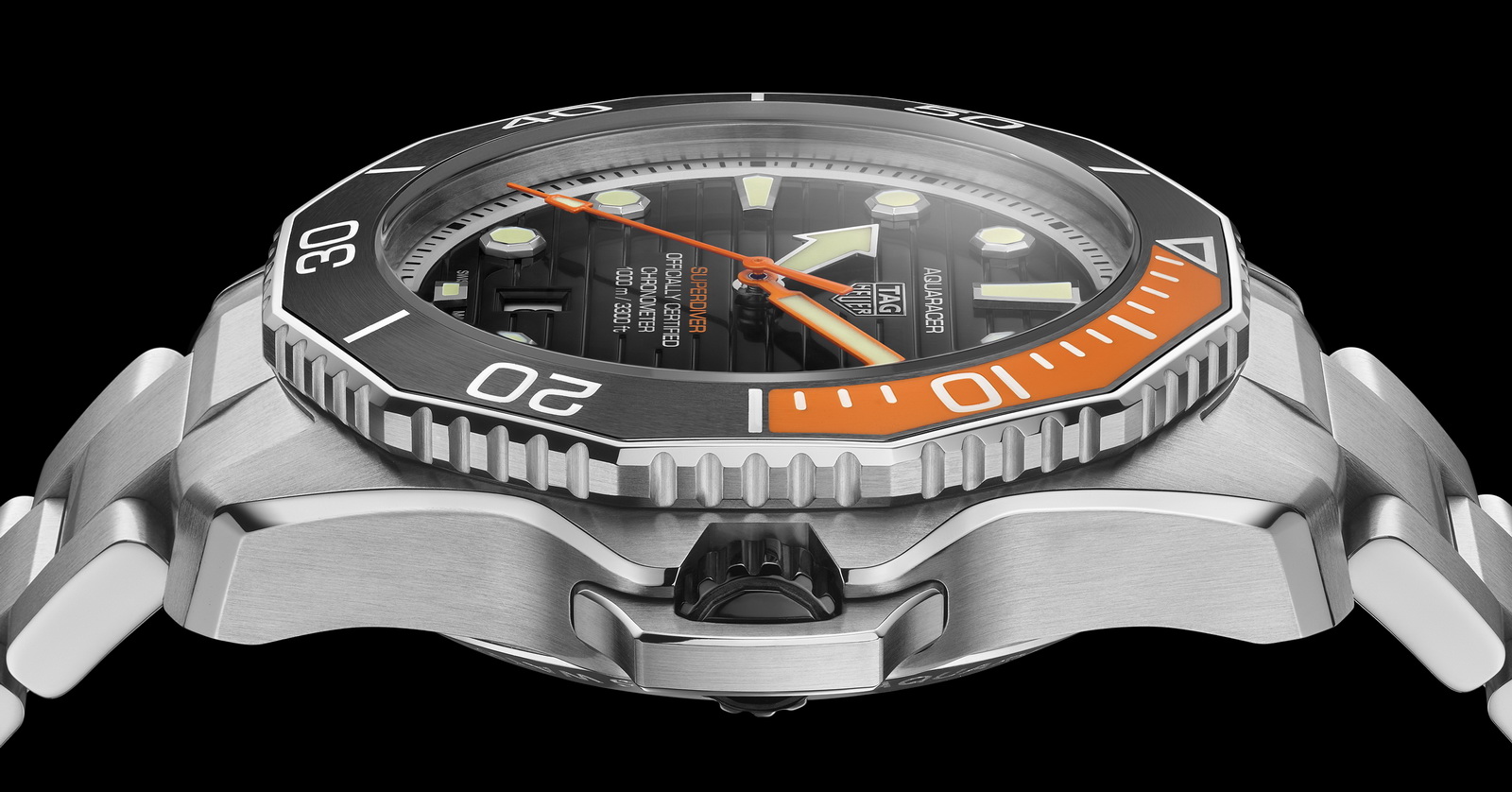
Whether the depth rating is 200 meters or 1000 meters, the new Aquaracer Superdiver has many features which make it attractive. I spend a good part of the summer wearing titanium watches or chronographs on titanium bracelets, and it will be interesting to see how this one feels on the wrist. The new Superdiver will also mark the debut of a new movement for TAG Heuer, the Calibre TH30-00, manufactured for TAG Heuer by Kenissi Manufacture SA and chronometer-certified by COSC (Contrôle Officiel Suisse des Chronomètres).
Additional References
The following postings provide some interesting information about dive watches:
Revolution — A History of the Dive Watch
OnTheDash — TAG Heuer Dive Watches – The Oldest, the Newest and 25 of the Years in Between
Calibre11.com — Heuer / TAG Heuer 1000 Meter & Spirotechnique — The Ultimate Collector’s Guide
Calibre11.com — TAG Heuer Aquaracer — The Ultimate Collector’s Guide
Special Thanks
Huge thanks to Justin Bennett, of TAG1000Diver.com, for providing valuable information and insights regarding the watches discussed in this posting, as well as the photos showing the crystals and gaskets of some of the watches. Justin sells and services the early Heuer and TAG Heuer dive watches, and is a reliable source for these watches.
Jeff Stein
March 30, 2022
